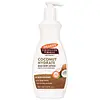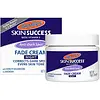What's inside
What's inside
 Key Ingredients
Key Ingredients

 Benefits
Benefits

 Concerns
Concerns

 Ingredients Side-by-side
Ingredients Side-by-side

Water
Skin ConditioningCocos Nucifera Fruit Extract
EmollientGlycine Soja Oil
EmollientButyrospermum Parkii Butter
Skin ConditioningIsopropyl Myristate
EmollientPropylene Glycol
HumectantCetyl Alcohol
EmollientPalmitic Acid
EmollientStearic Acid
CleansingCocos Nucifera Oil
MaskingTheobroma Cacao Seed Butter
EmollientTocopherol
AntioxidantTocopheryl Acetate
AntioxidantGardenia Taitensis Flower Extract
Skin ConditioningPrunus Amygdalus Dulcis Oil
Skin ConditioningMacadamia Ternifolia Seed Oil
EmollientAloe Barbadensis Leaf Juice
Skin ConditioningNonfat Dry Milk
Skin ConditioningCitric Acid
BufferingPotassium Sorbate
PreservativeSodium Benzoate
MaskingTriethanolamine
BufferingEthylhexylglycerin
Skin ConditioningCarbomer
Emulsion StabilisingGlycerin
HumectantPEG-40 Stearate
EmulsifyingTetrasodium EDTA
Pentylene Glycol
Skin ConditioningDecylene Glycol
Skin Conditioning1,2-Hexanediol
Skin ConditioningStearyl Alcohol
EmollientPhenoxyethanol
PreservativeParfum
MaskingBenzyl Alcohol
PerfumingBenzyl Benzoate
AntimicrobialCoumarin
PerfumingWater, Cocos Nucifera Fruit Extract, Glycine Soja Oil, Butyrospermum Parkii Butter, Isopropyl Myristate, Propylene Glycol, Cetyl Alcohol, Palmitic Acid, Stearic Acid, Cocos Nucifera Oil, Theobroma Cacao Seed Butter, Tocopherol, Tocopheryl Acetate, Gardenia Taitensis Flower Extract, Prunus Amygdalus Dulcis Oil, Macadamia Ternifolia Seed Oil, Aloe Barbadensis Leaf Juice, Nonfat Dry Milk, Citric Acid, Potassium Sorbate, Sodium Benzoate, Triethanolamine, Ethylhexylglycerin, Carbomer, Glycerin, PEG-40 Stearate, Tetrasodium EDTA, Pentylene Glycol, Decylene Glycol, 1,2-Hexanediol, Stearyl Alcohol, Phenoxyethanol, Parfum, Benzyl Alcohol, Benzyl Benzoate, Coumarin
Water
Skin ConditioningGlyceryl Stearate
EmollientParaffinum Liquidum
EmollientStearyl Stearate
EmollientNiacinamide
SmoothingPropylene Glycol
HumectantCetearyl Alcohol
EmollientPEG-100 Stearate
Ceteareth-20
CleansingPEG-75 Lanolin
EmollientDimethicone
EmollientIsopropyl Myristate
EmollientRetinol
Skin ConditioningTricholoma Matsutake Extract
Skin ConditioningTocopheryl Acetate
AntioxidantLavandula Angustifolia Oil
MaskingLeuconostoc/Radish Root Ferment Filtrate
AntimicrobialAscorbyl Glucoside
AntioxidantButylene Glycol
HumectantXanthan Gum
EmulsifyingDisodium EDTA
Magnesium Aluminum Silicate
AbsorbentCaprylic/Capric Triglyceride
MaskingSodium Sulfite
PreservativeSodium Metabisulfite
AntioxidantCitric Acid
BufferingBHT
AntioxidantPhenoxyethanol
PreservativeEthylhexylglycerin
Skin ConditioningSodium Lauryl Sulfate
CleansingSodium Sulfate
Linalool
PerfumingLimonene
PerfumingWater, Glyceryl Stearate, Paraffinum Liquidum, Stearyl Stearate, Niacinamide, Propylene Glycol, Cetearyl Alcohol, PEG-100 Stearate, Ceteareth-20, PEG-75 Lanolin, Dimethicone, Isopropyl Myristate, Retinol, Tricholoma Matsutake Extract, Tocopheryl Acetate, Lavandula Angustifolia Oil, Leuconostoc/Radish Root Ferment Filtrate, Ascorbyl Glucoside, Butylene Glycol, Xanthan Gum, Disodium EDTA, Magnesium Aluminum Silicate, Caprylic/Capric Triglyceride, Sodium Sulfite, Sodium Metabisulfite, Citric Acid, BHT, Phenoxyethanol, Ethylhexylglycerin, Sodium Lauryl Sulfate, Sodium Sulfate, Linalool, Limonene
Ingredients Explained
These ingredients are found in both products.
Ingredients higher up in an ingredient list are typically present in a larger amount.
Citric Acid is an alpha hydroxy acid (AHA) naturally found in citrus fruits like oranges, lemons, and limes.
Like other AHAs, citric acid can exfoliate skin by breaking down the bonds that hold dead skin cells together. This helps reveal smoother and brighter skin underneath.
However, this exfoliating effect only happens at high concentrations (20%) which can be hard to find in cosmetic products.
Due to this, citric acid is usually included in small amounts as a pH adjuster. This helps keep products slightly more acidic and compatible with skin's natural pH.
In skincare formulas, citric acid can:
While it can provide some skin benefits, research shows lactic acid and glycolic acid are generally more effective and less irritating exfoliants.
Most citric acid used in skincare today is made by fermenting sugars (usually from molasses). This synthetic version is identical to the natural citrus form but easier to stabilize and use in formulations.
Read more about some other popular AHA's here:
Learn more about Citric AcidEthylhexylglycerin (we can't pronounce this either) is commonly used as a preservative and skin softener. It is derived from glyceryl.
You might see Ethylhexylglycerin often paired with other preservatives such as phenoxyethanol. Ethylhexylglycerin has been found to increase the effectiveness of these other preservatives.
Isopropyl Myristate is an emollient, thickening agent, and texture enhancer. It is created from isopropyl alcohol and myristic acid.
It is used to help other ingredients be better absorbed. It is also an emollient and may help soften and hydrate the skin.
The comedogenic rating of this ingredient depends on the concentration. Lower amounts results in a lower rating.
Isopropyl Myristate may not be fungal acne safe. It can potentially worsen acne prone skin.
Learn more about Isopropyl MyristatePhenoxyethanol is a preservative that has germicide, antimicrobial, and aromatic properties. Studies show that phenoxyethanol can prevent microbial growth. By itself, it has a scent that is similar to that of a rose.
It's often used in formulations along with Caprylyl Glycol to preserve the shelf life of products.
Propylene Glycol is an odorless, colorless liquid. As a humectant, it helps skin retain moisture. It also aids in delivering active ingredients.
Another role of this ingredient is preventing a product from melting or freezing. Propylene glycol also adds antimicrobrial properties to a product, elongating product lifespan.
This ingredient is considered an organic alcohol and commonly added into both cosmetics and foods.
Those with sensitive skin or conditions may develop a rash when using this ingredient.
Learn more about Propylene GlycolTocopheryl Acetate is AKA Vitamin E. It is an antioxidant and protects your skin from free radicals. Free radicals damage the skin by breaking down collagen.
One study found using Tocopheryl Acetate with Vitamin C decreased the number of sunburned cells.
Tocopheryl Acetate is commonly found in both skincare and dietary supplements.
Learn more about Tocopheryl AcetateWater. It's the most common cosmetic ingredient of all. You'll usually see it at the top of ingredient lists, meaning that it makes up the largest part of the product.
So why is it so popular? Water most often acts as a solvent - this means that it helps dissolve other ingredients into the formulation.
You'll also recognize water as that liquid we all need to stay alive. If you see this, drink a glass of water. Stay hydrated!
Learn more about Water